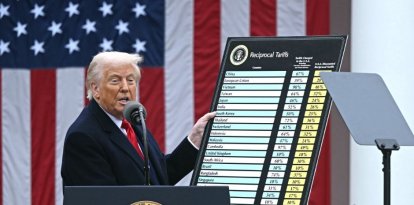The nine states where the Hispanic vote is key
New Mexico, California, Texas, Arizona and Florida are the states with the highest percentage of Hispanic voters.

Ron DeSantis and Donald Trump (Trump White House Archived/Flickr)
Under the umbrella of "Hispanics" is a very jumbled reality, with different origins and diverse economic or cultural conditions. This does not mean that there is not a very important common element, such as the Spanish language and the shared cultural heritage.
More than two-thirds of what is now the United States belonged to Spain. That means there are Hispanics whose family has been on U.S. soil longer than some of the founding fathers. Other Hispanics are second or third-generation while others have just arrived, not all of them legally.
The Hispanic population continues to grow, and this is reflected in political influence. Although citizens of Hispanic origin are present throughout the territory, there are certain states in which their presence is significant, and in some, the way they vote is key. These are the nine states where the Hispanic vote is key:
New York
In New York, Hispanics account for 15% of eligible voters, according to an LSG report, which is based on Census Bureau data corrected by Pew Research estimates.
In the state, Senate Majority Leader Chuck Schummer (D) leads in the polls to keep his seat with an average of 14.4 points over Republican Joe Pinion, according to the Real Clear Politics average. Fellow Democrat Kathy Hochul holds a 6.2-point lead over Republican Lee Zeldin in the race to be the state's next governor. New York contributes 28 electoral votes to the presidential election.
New Jersey
There are no gubernatorial or senate elections in New Jersey. Around 16% of the population is Hispanic, and the state contributes 14 votes to the electoral college, which elects the president.
Colorado
Seventeen percent of Colorado's citizens are Hispanic. Like New York and New Jersey, Colorado is a Democratic state. The polls show that there is a Democratic lead in both the Senate (Michael Bennet (D) trails Joe O'Dea (R) by 5.3 points) and the state (Jared Polis (D) leads Heidi Ganahl (R) by 13 points). Colorado contributes 10 electoral votes.
A study conducted by the Americas Society / Council of the Americas shows that 50% of Hispanics in the state have expressed their intention to vote Democrat in the House of Representatives, with 15% opting for the Republican Party and 28% being undecided.
Nevada
Nevada is one of the fastest-growing and most important states for the Hispanic vote. Twenty-one percent of voters come from Spanish-speaking families. The distribution of voting intentions is similar: 53% will vote for the Democratic candidate in their district, while 17% will vote for the Republican candidate. Nearly 23% have not yet indicated whether they will vote or which candidate they will vote for.
Adam Laxart, the Republican candidate for Nevada's Senate seat for the next six years, leads Democrat Catherine Cortez Masto by 1.9 points. Real Clear Politics believes this is enough to give Laxart the win, considering the pro-Democrat bias of the polls. The same situation with the gubernatorial candidates is similar: Joe Lombardo (R) is 1.8 points ahead of Steve Sisolak (D), and RCP believes Lombardo will be the winner.
Florida
In Florida, the Hispanic presence is the same as in Nevada: 21%. A large part of this community is of Cuban origin, for geographic reasons. Many of them have relatives who suffer from the Castro dictatorship, and that influences their vote. In Florida, 43% will vote Democrat, according to AS/COA, with 18% undecided and 36% of Hispanics voting Republican. There are 3.4 million Hispanics in the state.
Florida is one of the swing states. Those states can go either way and are decisive in the presidential elections. Florida contributes 30 electoral votes. These midterm elections seem to indicate that Florida is swinging toward the Republican Party, a concern among Democratic Party analysts.
Republican Marco Rubio's lead over Democratic candidate Val Demings in the RCP polling average has widened in recent days to 7.5 points. Ron DeSantis, a rising star in the Republican Party, has an 11.8-point lead over Charlie Crist (D).
Arizona
In Arizona, one in four voters is Hispanic. Of that 25%, 53% vote Democrat versus 19% vote Republican. 22% are undecided. The Copper State contributes 11 electoral votes to the presidential race.
Mark Kelly (D) is seeking to be reelected to the Senate in Arizona, but the gap between him and Republican Blake Masters has been shrinking, from 6 points on Sept. 8 to 2.3 points now. RCP calls them a tie. In the same state, Kari Lake could be the new governor and become one of the new stars of the Republican Party. RCP predicts she will win, with an average poll lead of 2.8 points.
Texas
The next largest states in terms of the Hispanic population are Texas and California, with 32% Hispanic presence in both cases. In the case of Texas, the majority of the Hispanic vote is for the Democratic Party (54%), with 22% voting Republican and 19% who have not expressed their intention to vote. There are 6.2 million Hispanics in Texas, a state that provides 40 electoral votes. In the Lone Star State, Greg Abbott leads Democrat Beto O'Rourke by 9.2 points.
Abbott is another figure who may have a role in the Republican Party, especially if Donald Trump does not decide to run again in 2024.
California
A leading figure in his party is Gavin Newsom (D), governor of California. His state is home to 8.3 million Hispanics, who make up one-third of the state's voters (32%). Both Newsom and Senator Alex Padilla are likely to be reappointed on November 8. There, 59% of Hispanics vote Democrat, with only 14% who vote Republican.
California is the most populous state in the country. For that reason, it is the state to which most districts are assigned, contributing 52 members of the House of Representatives. Therefore, the number of electoral votes (the number of representatives plus the two senators) is 54.
New Mexico
New Mexico is by far the state where the Hispanic vote carries the most weight. 44% of the state's voters are Hispanic. There are no elections there for senators, but Michelle Lujan Grisham hopes to be reelected governor of New Mexico. The RCP polling average recognizes a 4-point advantage over her rival, Republican Mark Ronchetti.
RECOMMENDATION





















